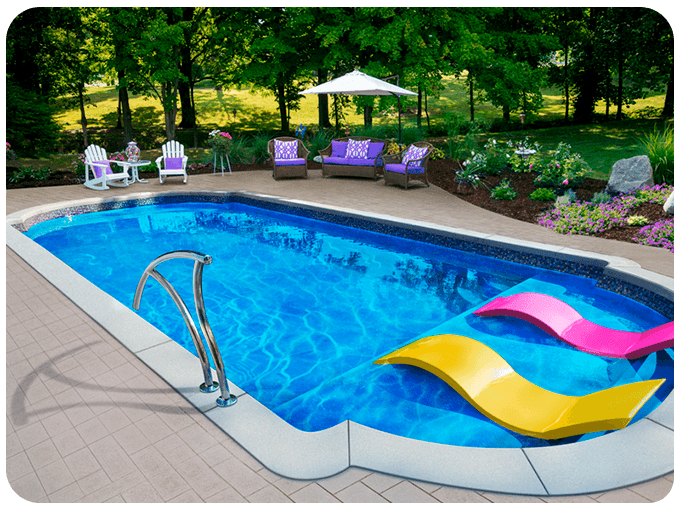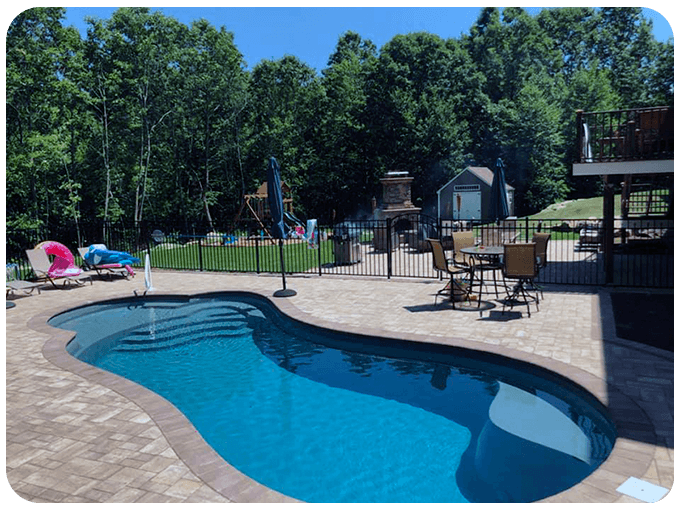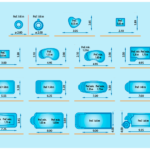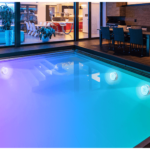In some places, it’s hot enough to swim year-round, while in others, it’s the peak of hot, sunny days. Whether you’ve been thinking about it for a while or the heat of this summer is starting to get to you, you’re likely here because you’ve been considering getting your own inground pool. More specifically, you want to learn more about the pros and cons of fiberglass inground pools.
Table of Contents
Why Choose a Fiberglass Pool?
Fiberglass pools have many advantages over alternatives. Unlike other pools, fiberglass pool installation can be done quickly. Homeowners purchasing a fiberglass pool will enjoy their new pool within days of delivery, regardless of the pool’s size or shape.
Concrete pools crack and have a much rougher surface. In contrast, the slick feel of a fiberglass pool offers a more enjoyable swimming experience (no scratches on sensitive hands and feet) and helps minimize algae growth.

The smooth finish of a fiberglass pool provides a comfortable, scratch-free swimming experience and gives you peace of mind that your children can swim without worrying about scraping their bodies on a rough surface, which can happen with concrete pools. Fiberglass is also much easier to clean: think about the effort needed to scrub grout off tiles compared to the smooth lining of a bathtub.
More Advantages in Fiberglass?
Other pool alternatives can break down, while a fiberglass pool will maintain its pristine appearance over time. Different manufacturers use ceramic, resin, gel coat, fiberglass, and high-quality Kevlar materials to ensure that your fiberglass pool maintains its appeal indefinitely.
A fiberglass pool even has an advantage when it comes to hygiene: you’ll need 30% less chlorine to keep your pool clean for swimming.
While a fiberglass pool may be slightly more expensive than other types of pools in terms of upfront cost, it’s much easier to maintain and will last forever. You won’t have to factor in future maintenance expenses, like repaving, when estimating the total cost of your pool.
Pros and Cons of Fiberglass Pools
Often, the best way to compare options is to look at the pros and cons of each choice. Inground fiberglass pools certainly have their advantages, but they can also have their disadvantages. Let’s take a quick look at each:
Pros:
- Lower maintenance.
We say lower, but that doesn’t mean none. All inground pools, regardless of type, will require time and energy to maintain. If you’re eager to learn the ins and outs of inground pool maintenance, we have an excellent eBook that compares the 3 types of pools by maintenance and installation, with durability factors included (and it’s free!)
- Smooth surface.
Fiberglass pools are often recognized as durable and comfortable to walk on. Some fiberglass pool manufacturers will use an anti-slip gel coat (which gives the pool its “true color”) to make it smoother and safer for swimmers. So, if you’ve been wondering, “are fiberglass pools slippery?”: their non-slip qualities reduce the risk of falls. However, any smooth surface in water can pose a risk, so always exercise caution!
- Generally faster installation times.
We also say “generally” because there are factors that can increase the completion time of your project, like increased demand, labor or material shortages, etc. As a rule of thumb, fiberglass pool installation can take anywhere from 2 to 6 weeks on average.
Cons:
- Not customizable.
Inground fiberglass pool manufacturers build their pools from a mold. This mold, like a baking mold, contains all the details and features of that particular pool. Once all the “ingredients”/materials are applied and the pool has cured, it’s removed from the mold and you’re left with a nice pool and a nice mold that’s ready to make another pool. Because all batches are produced from the same mold, you can’t move features around or add/remove them. If you have a very specific design in mind for your pool and can’t find it on the manufacturer’s website, you may need to look into gunite or vinyl.
- Can only reach up to a certain size.
This is primarily due to shipping restrictions. Have you ever seen a pool being transported down the highway in the back of a truck? It was most likely a fiberglass pool shell traveling to its final destination. To travel where it needs to go, fiberglass pools can only reach about 16 feet wide and 40 to 41 feet long. Anything beyond that and you may run into trouble getting it where it needs to be.
- Not always the most budget-friendly option depending on your budget.
Vinyl-lined pools are typically the most affordable type of inground pool, fiberglass comes in second, and gunite/concrete is usually the most expensive. Of course, there are always exceptions depending on where you live, what type of pool is most common/comfortable for pool builders in your area, the needs of your individual pool project, etc.

Are there options for smaller fiberglass pools?
Certainly, if you have a large backyard with tons of open space, a large pool is likely a viable option to fill it. But what if you have a smaller yard or just envision yourself using a smaller pool? Fear not, dreamy homeowner: there are certainly small fiberglass pools for you to choose from.
What is the smallest fiberglass pool size you can get? This will depend on the manufacturer you choose. The smallest rectangular design available is 2×2 or 3×2, and it’s also available in circular shape. However, some manufacturers may offer options like children’s pools that come in even smaller sizes and provide a place to dip your feet or have little ones splash around.”


